Part 13: - Settling In
1958 - Settling In
Q1 1958
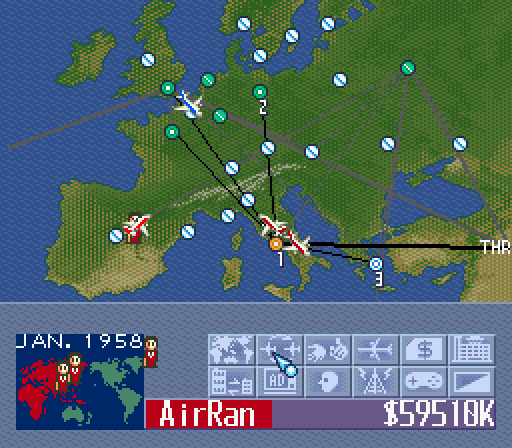
After highly their disappointing openings, our routes in France and Germany are scaled back to run IL14s. Berlin showed more enthusiasm, so they get priority for air-time over Paris. Athens is scaled up to 5 Flights per week. If they fill, the Greeks may get one of the DC6s we just freed up. London and THROM continue to thrive. They would be first in line for expansion bids this turn, but we’ve hit two bottlenecks: Rome is full, and we need more planes. One takes time, the other money that we’ve committed to building our next big links out east.
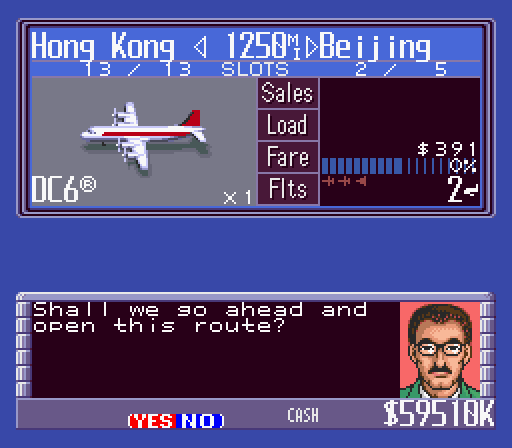
As ordered, we go into Beijing. From Athens, we’ve learned that population has a massive impact on demand, so I deploy a DC6. There’s only 2 slots free right now in Hong Kong, and no more will be open to bid on until next turn, so an IL14 wouldn’t get enough time to move much volume. I’m betting that China can fill all those seats.

Good news at home - with everyone working out of Tehran there’s lots of pressure on the airport to expand. They’ve gone straight into another building project after finishing their first. Since this is quick and easy, I send Jerry to secure our share of the new slots. It’s technically a lower priority than bidding for our link to Bangkok, but we’ll need a while to gather the opening cost anyway. We have time to spare.
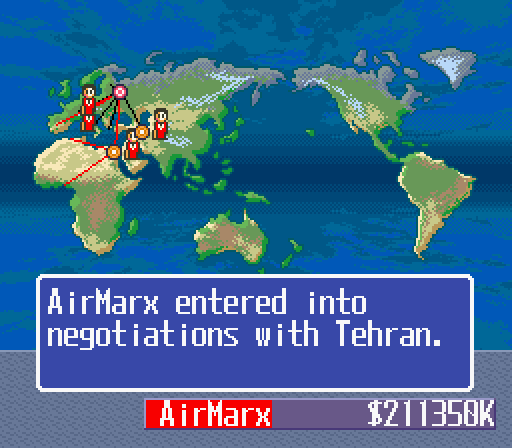
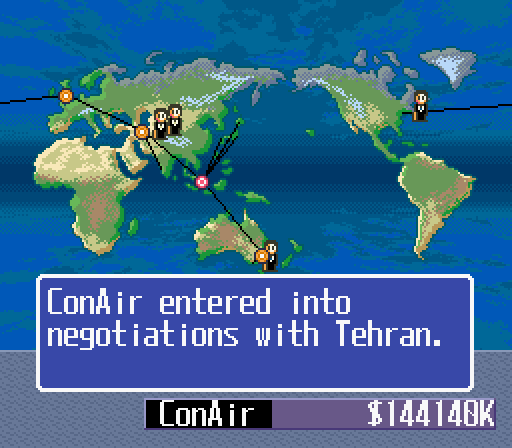
Everybody wants a piece of that fresh Iranian tarmac.
ConAir also opened their first transatlantic flight, becoming the first of us to advance into Air’Murica’s territory.
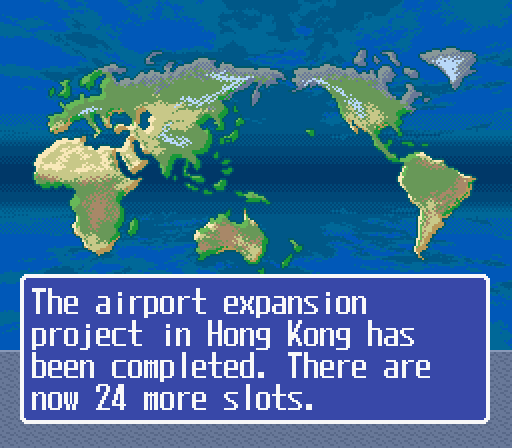
We'll get right on those.
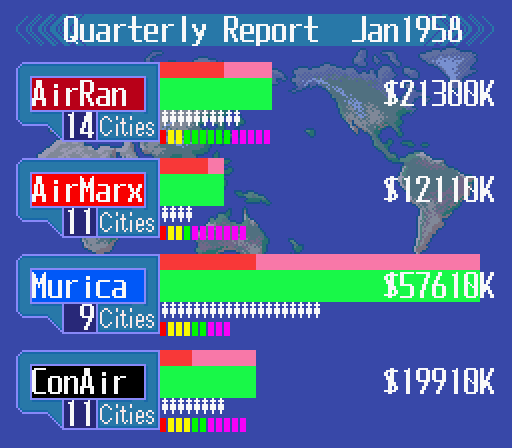
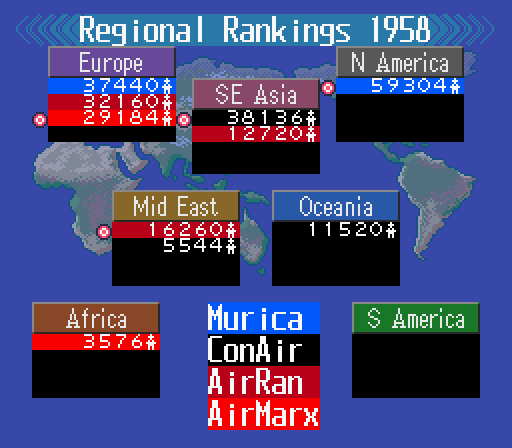
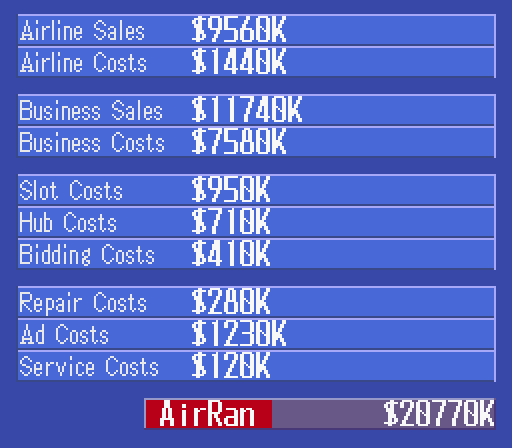
Not a bad turn. We’re staying competitive on all fronts and our cashflow continues to slowly rise. Our businesses appear to be responding well to the growth of the network. The hotel in Rome alone pays out $3 million on a good turn. The others are far more modest, giving back a few hundred thousand.

Hail Satan.
Q2 1958
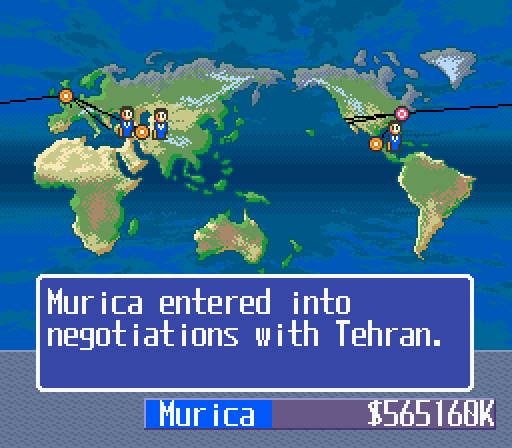
Late to the party, Blue.
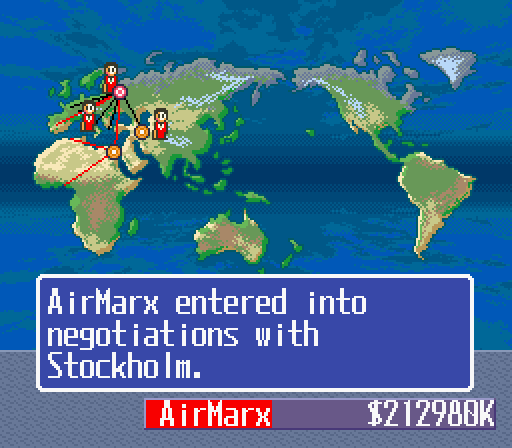
Passengers of Air Marx begin to develop an irrational sympathy for their service provider. They also open a route to Paris. At least they’re buying and using more Viscounts. They may yet recover from owning Tupolevs.

Like us, ConAir is slowing down as they start to run low on liquid assets. The AI doesn’t live as dangerously as we do.
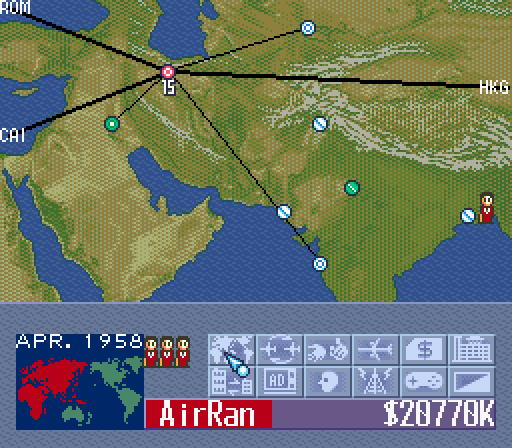
Old bids from last year in Madrid and Singapore clear. It will be a while before we can afford to put those slots to use, but they don’t cost much to hold on to. More importantly, Jerry renews our dominance of Tehran.


China does us proud. Beijing is off to a strong start, and it looks like our increased presence out here is improving demand for THR-HKG.

With breathing room up for sale in Hong Kong, our next offensive is focussed on the east. Veronica to Bangkok, Igor to HK and Jerry into Kuala Lumpur. I chose it over yet more time China because they can handle 2 more flights without adding any new planes. We’re down to an IL14 earmarked for Bangkok, and a DC6 waiting to tag in on our best long haul.

Yeah, fuck you too, France. Way to get upstaged by Baghdad. I cut their flights back more, reassigning them mostly to Berlin. Our good routes in Europe are making full use of their current aircraft, so I decide to send out our last DC6.
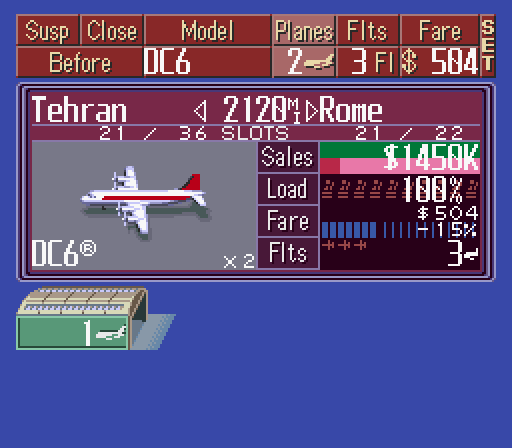
Three flights on THROM bring in more than 5 to Athens, so I assign it to the connector. It adds capacity for two more fights. I use one for now.
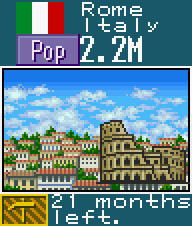
Space will be tight in Europe for a while. If we chose to try more hookups we can always skim time off Paris and Berlin.
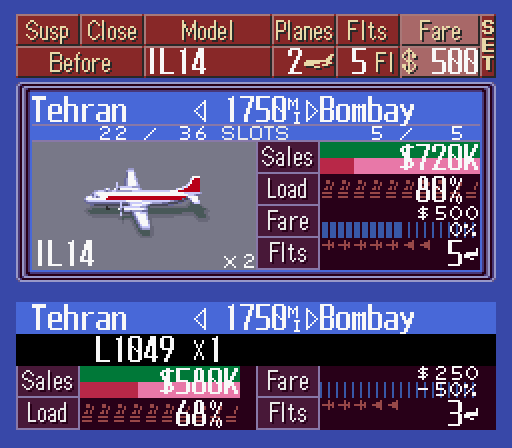
Here, we see some of the AI’s exploitable behavior on display. ConAir is using rock-bottom prices to steal passengers from us in India, and it’s working. They’re moving about 180 people each week vs our 120. However, our smaller flights brings in 25% more revenue from those high-price tickets, at lower operating cost than their fatass Lockheed Constellation. A good move on the scoreboard, but a bad one on the ledger. I cut a little discount to lure some of those passengers back. No reason not to rub salt in the wound.
Luring our opponents into traps like these is handy for getting ahead.
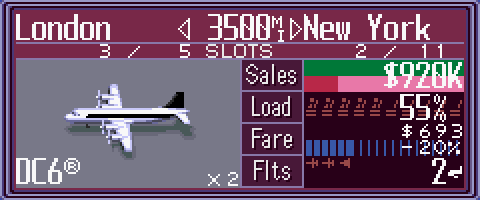
ConAir has a less than amazing start heading overseas, but London to New York is such a good route that even half-full budget flights make decent scratch.
This is what they’re up against.
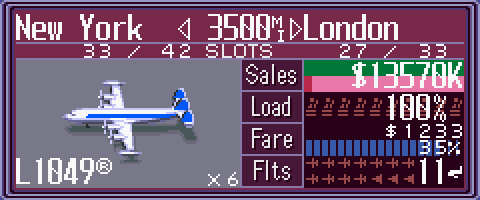

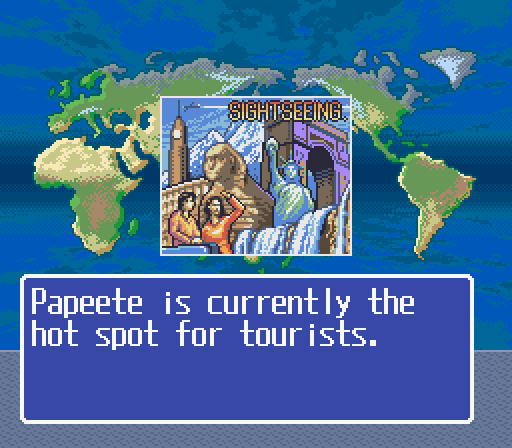
More popular pacific islands, and Sydney adds 26 more slots.
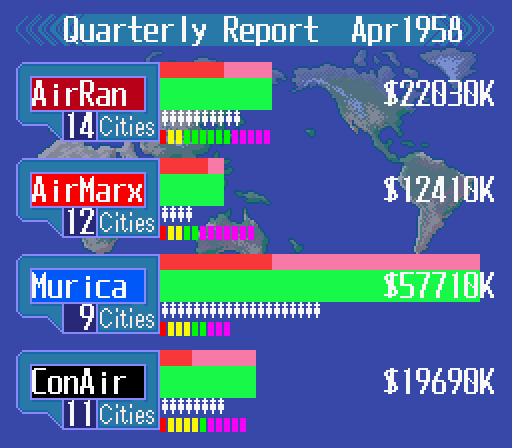
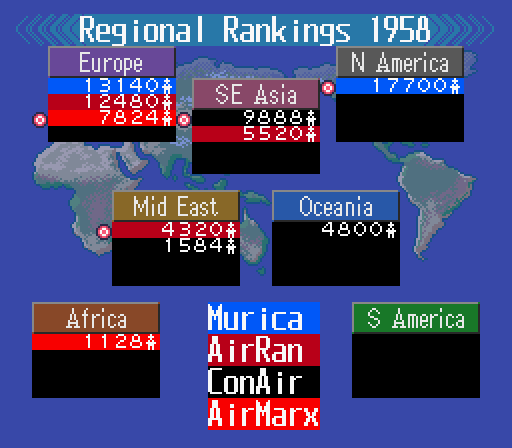
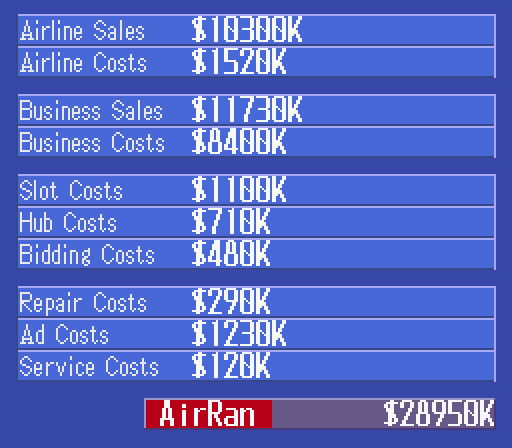
We hold steady through this turn, adding $750K in air sales without spending any capital.
Q3 1958
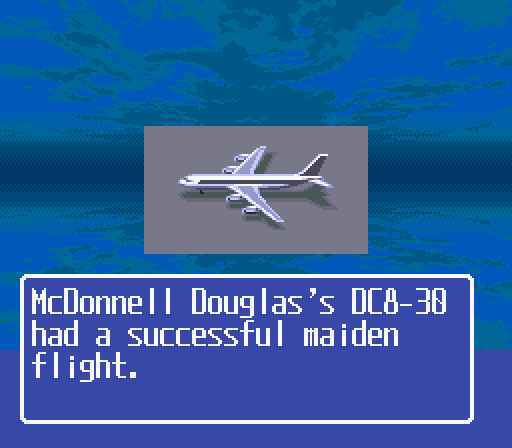
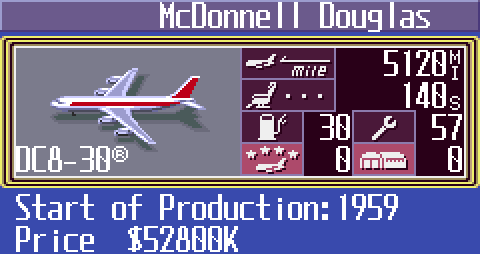
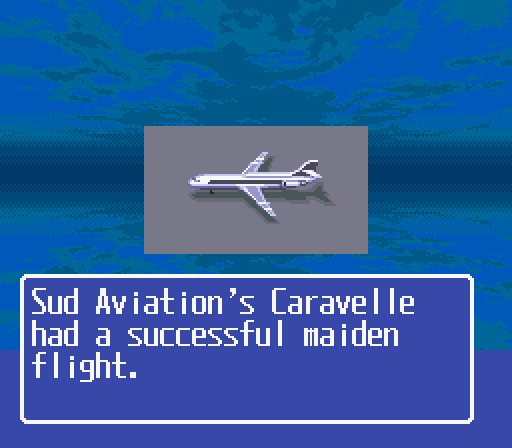
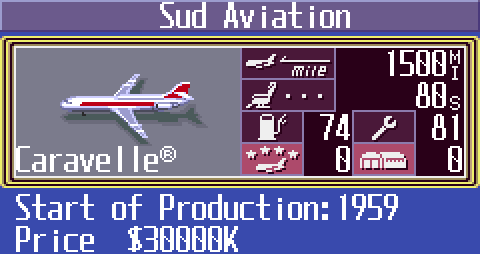
The Jet Age continues to dawn.
DC one-ups Boeing with a farther reaching and slightly more fuel-efficient skywhale, while newcomer Sud Aviation puts out a smaller short-range jet that’s nearly as reliable as a turboprop.
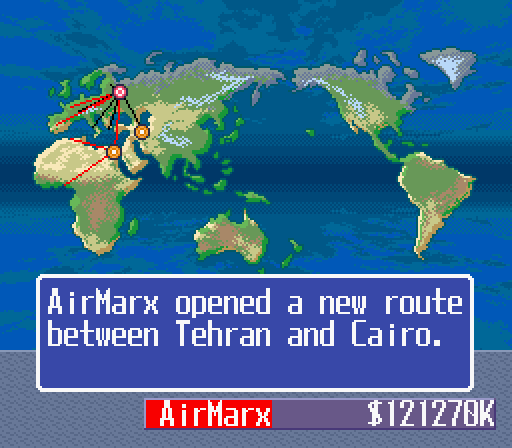
Air Marx links Tehran to Cairo, hook up Barcelona, and bid in Brussels and Calcutta.
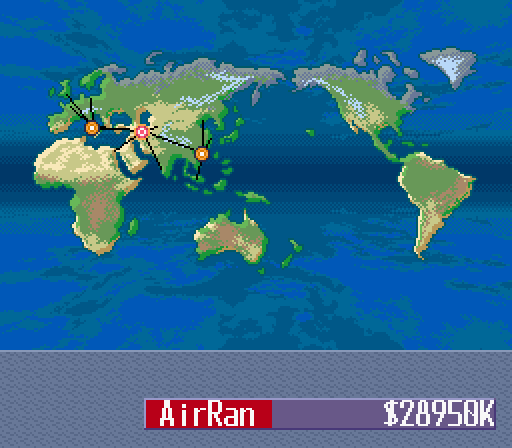
While it may not be as patriotic, we prefer not the paint the map red.

One of those is going straight to Beijing. Any more will need more planes.

City, solved. There is a hard cap of 14 flights per week on any given route. The only reason to hold more time than that in any non-hub city is to deny it to your enemies.
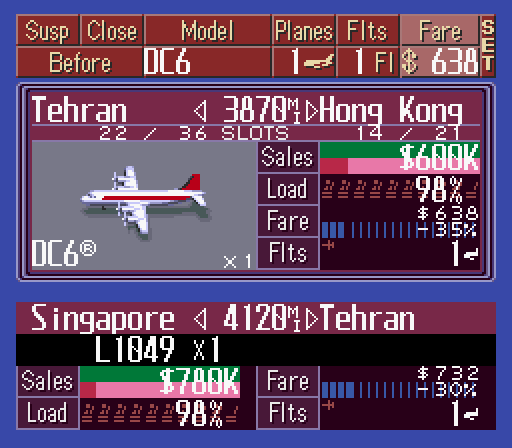
Our eastern connection is maturing nicely. It’s no THROM, but we’re climbing into the same league as ConAir.

Speaking of, THROM is still amazing. I should strip more flights from Paris’ scrawny little schedule and feed them to THROM (Finally filling 3 flights for $210K per quarter) but I spare it the knife for now. They get a rate hike and a second chance to live up to the standards set by air-travel giants like Iraq, Malaysia and Uzbekistan.
Belin’s doing much better, filling 5 flights for $460K.

The Greeks break a million, and hunger for more. I gouge a bit until we have more time to give them. I’ll be 18 more months before Rome grows, Q1 1960.
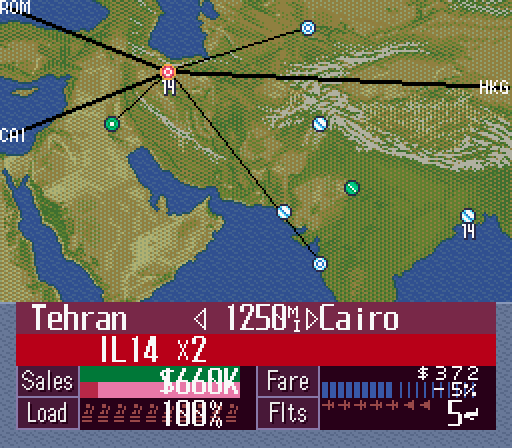
Tehran has all the time in the world, so bidding turns to growing routes at home. As before, I look for links that handle more traffic with their current supply of aircraft. There’s space for 2 more flights to Cairo and Bombay, 4 to Baghdad, and 1 more to Tashkent. Baghdad earns the least per flight, putting it at the back of the line. Tashkent has the least to gain from bids without more planes to fill them, so they’re out too. That leaves the very close performances of Cairo and Bombay.
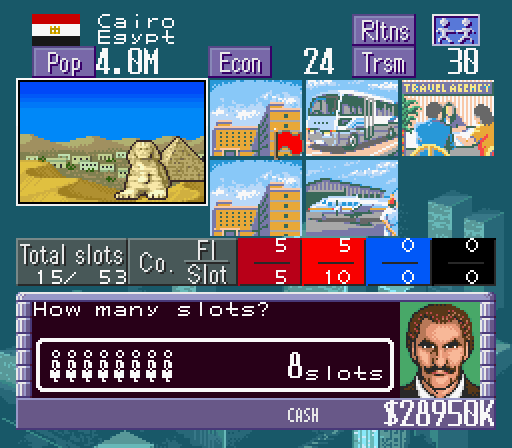
Egypt is doing a little better, and will be our future hub in Africa, so it wins out. Igor’s on it. The Russians have held back here, so there’s still a good chance that we can get control here. For all that control of Africa is worth.
Since Cindy’s also free, I send her back to Bombay for 6 more slots. It’s all we can expect from their tiny airport. It will take 9 months.
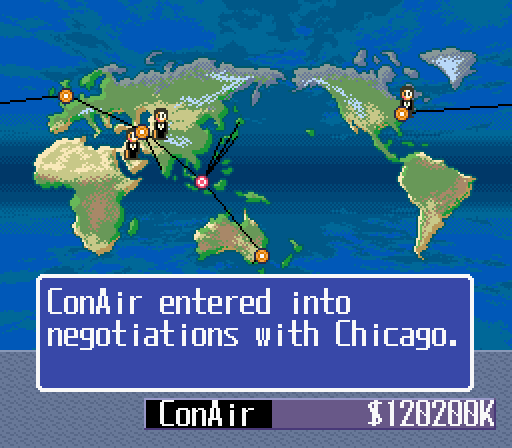
They fish around more in the Middle East, linking Karachi and bidding in Tehran. The real news is their bids in America. One the one hand, our largest enemy will soon have competition. On the other, it will be from our nearest rival.
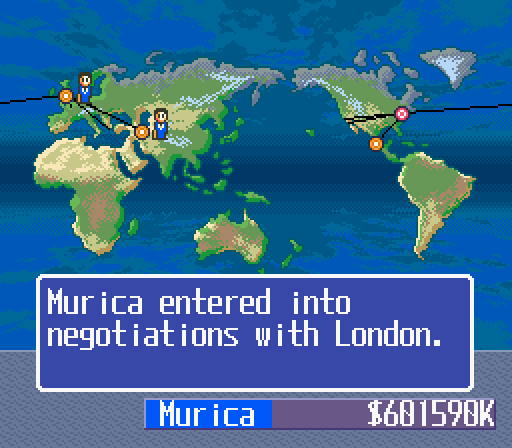
More Slots, more L1049s. Standard ‘Murica turn.

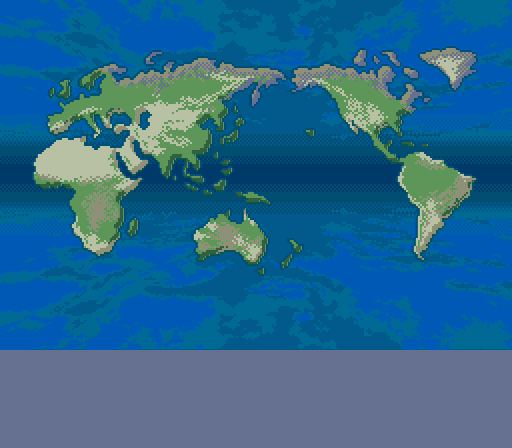
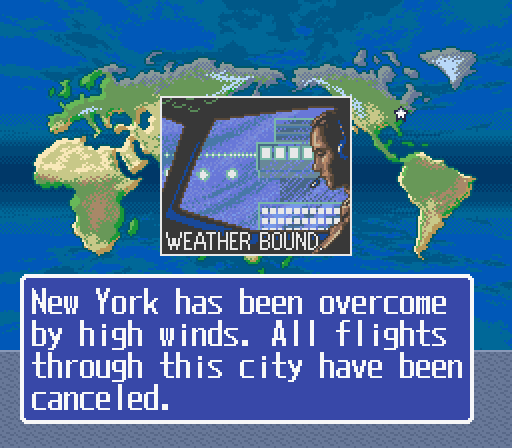
Severe weather disrupts flights in New York.
Papeete remains a popular tourist destination
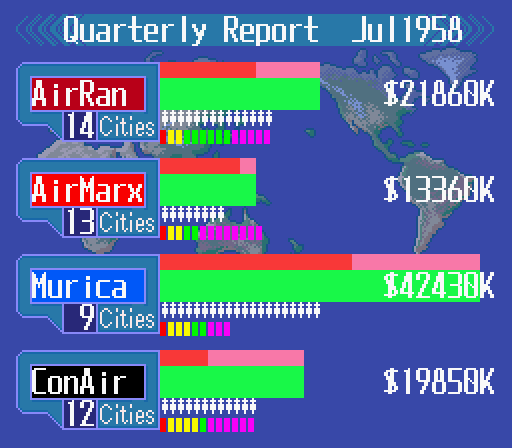
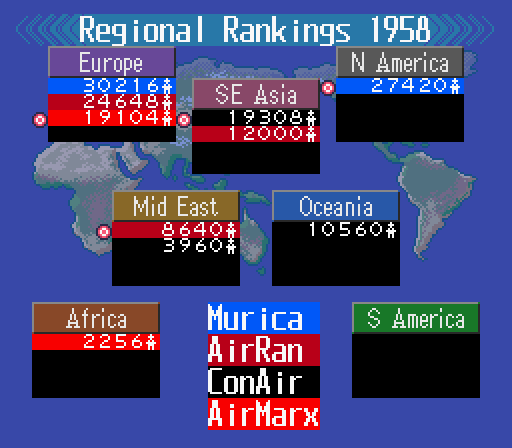
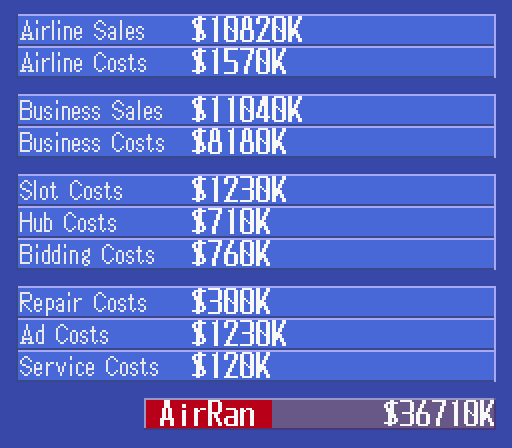
That storm cost the Americans $15 Million and 11,184 passengers.
Allah Akbar.
Q4 1958
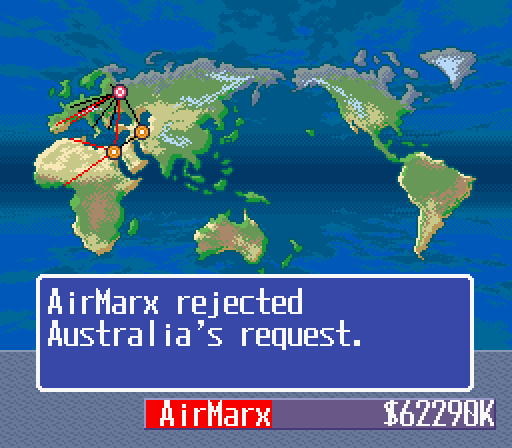
Diplomats will shop around to different airlines with their deals. The Russians don’t want this one, so they’ll be coming to us next.
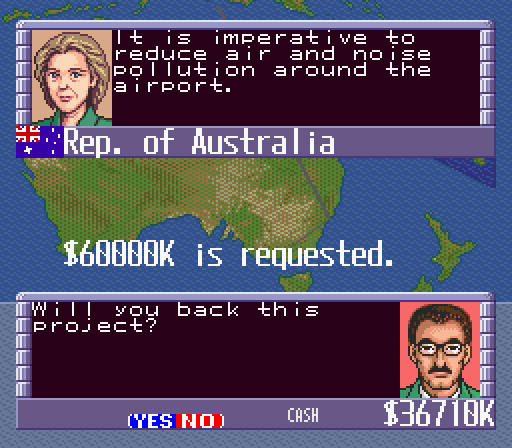
The Australians want to clean up Perth. While this would mean great things for our eventual work in Oceania, they ask for far too much. We send them on their way.

Our bidding out east clears, and we have the cash on hand, so Bangkok is added to our network. All we have on hand to fly it is an IL14, but we know the 3 flights it can handle will be good ones. We also schedule two more flights to Kuala Lumpur. All of our planes are now in action, and all planes in Southeast Asia are working at full capacity.

In a bit of emergent gameplay, we’ve wound up colluding with ConAir to keep Trans-Asian ticket prices high. The AI feels comfortable charging a little more than us on their connecting flight, and every time they’ve raised their fares I’ve raised our own to keep pace. They respond by raising theirs in turn, and both routes benefit until someone new shows up to undercut us. Game theory in action!

With two agents free and no cash on hand to give them, I close out with more bids at home. Veronica to Baghdad and Jerry to Tashkent. 6 months each for 5 and 7 slots. Taken together, we’re getting close to all the slots we should ever need in the Middle East.
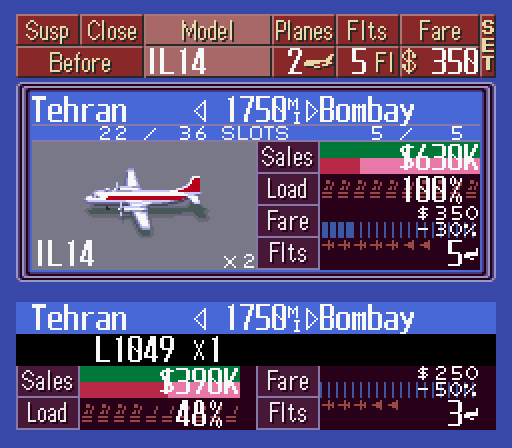
The results of closing the trap in Bombay. In exchange for $100K of our revenue, we’ve pinned them down in a downright Parisian quagmire. At least Paris was relatively cheap to connect to. In this state, ConAir’s flight will probably never pay back its startup costs. Since we’ll soon have even more flights to fill there, I squeeze prices even tighter.
Listen closely around sunset, when the wind is right, and you will hear Danny Yang cry himself to sleep.
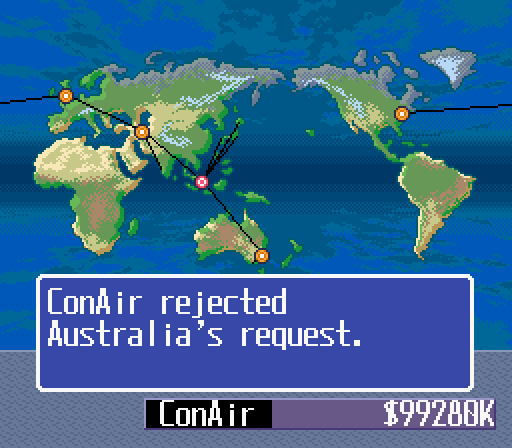
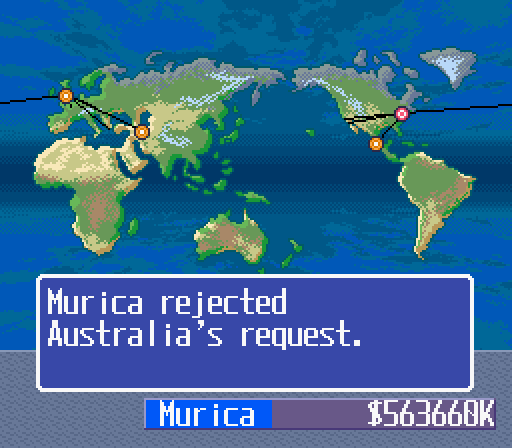
No one wants to clean up Perth.
The Americans also link Karachi and bid in Tashkent.
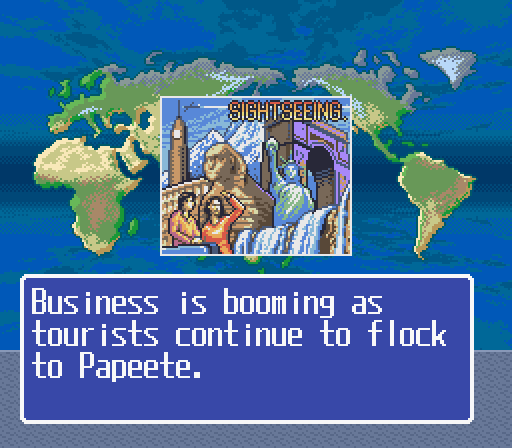
The most popular island that no one is flying to. Tourists will have to try their luck with boats.
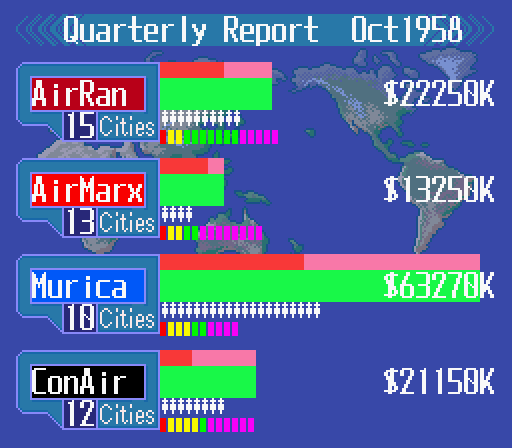
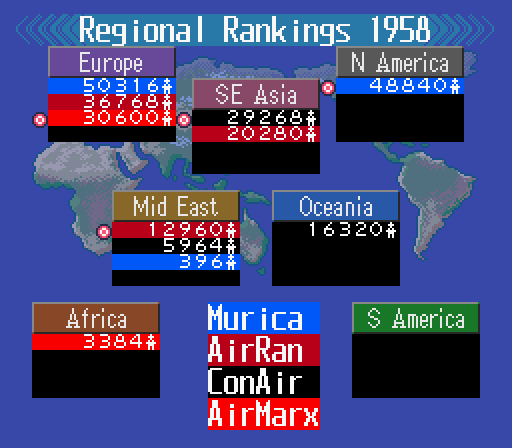
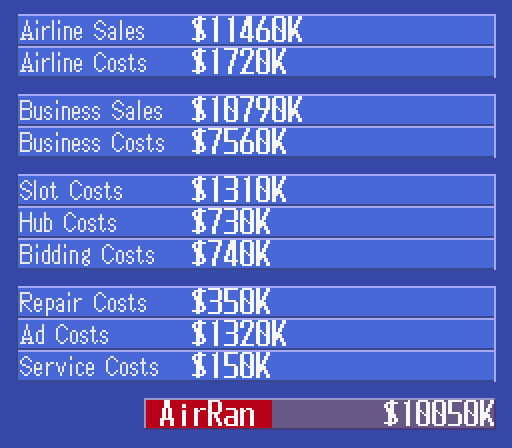
Without the wrath of god holding them down, Air’Murica pops right back to their normal place. We’re keeping slow and steady pace.

1958 Year-End Review
Only the Russians go before us, connecting Sweden and doing some bidding in the motherland.

This year brought our cash reserve to an all-time low. Our startup funds are spent. (Going back and adding up the numbers, we actually went through the last of our initial capital around the end of 1957.) From here on out, we’re living on the proceeds of our own assets. We shall live or die an Aero-Biz. And we’re not doing half-bad.
We’ve turned that initial $820 Million into a company that brought in $32.9 Million this year, an average of $8M per turn. That is money we can grow on. That’s a new route or two each year, or a couple midrange planes, or a nice hotel with a view of the beach. That is a return on investment that will see us double in size within 6 years.
In four years we’ve been built a network spanning two continents that moves ten thousand people every month.
It only goes up from here.
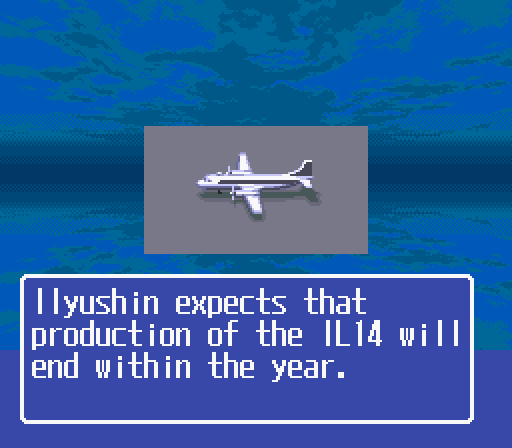
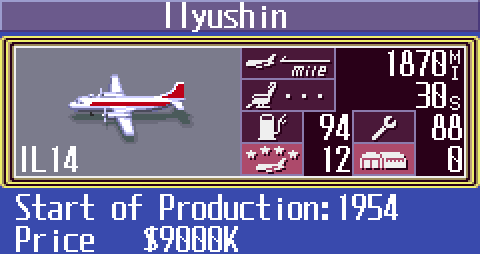
Our trusty Soviet workhorse is getting put out pasture. After 1959 all production of the IL14 will be discontinued. It’s last call to stuff our hangars with these tough little planes before they’re gone. The ones we have will continue to serve.
We’ve had a good run with the IL14. We’ve benefitted its strengths - low costs which let us make the most of all the little things we have. This year, we ran to its weakness - time. While an IL-14 focussed strategy is highly economical when it comes to cash, their low capacity means they need a lot of airport space to really scale up service. Time that adds up quickly in your hubs.
In exploring the markets, we’ve found plenty of cities that may be equipped to handle fewer flights from bigger planes.
Enter the Caravelle.

On the surface, this looks worse than the DC6. Same size, far less range, worse upkeep ratings and a bigger pricetag. On the surface, it is worse. However, aircraft in Aerobiz have a hidden stat - speed. Along with operating range, speed determines how many flights per week a plane can handle on a given route. In most cases, speed being hidden isn’t a problem as long as you know it exists. It’s enough to know that in general, jets are faster than props.
If you comb over the numbers, you’ll find that at max range a big turboprop like the DC6 and L1049 gets around 1.5 flights per plane. Lighter props like the Viscount and our IL14s get closer to 2 flights per plane. The Tu104, for all its countless failures as commercial passenger aircraft, nearly gets up to 3.
The higher speed of jet aircraft means more flights per plane - fewer planes per route.
Based on that, I believe the Caravelle is a worthy successor to the IL14 on some of our proven short-range routes, leaving the Ilyushins free to seek out new low-demand lines and do what they do best.
It’s time to start looking to the future.
Build our Plan for 1959.